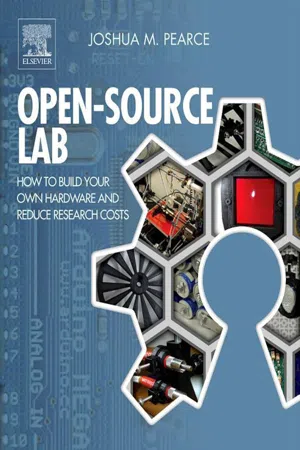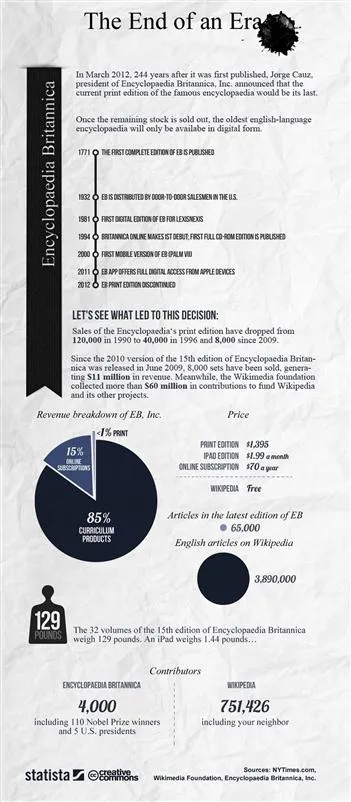
eBook - ePub
Open-Source Lab
How to Build Your Own Hardware and Reduce Research Costs
This is a test
- 240 pages
- English
- ePUB (mobile friendly)
- Available on iOS & Android
eBook - ePub
Book details
Book preview
Table of contents
Citations
About This Book
Open-Source Lab: How to Build Your Own Hardware and Reduce Scientific Research Costs details the development of the free and open-source hardware revolution. The combination of open-source 3D printing and microcontrollers running on free software enables scientists, engineers, and lab personnel in every discipline to develop powerful research tools at unprecedented low costs.After reading Open-Source Lab, you will be able to:
- Lower equipment costs by making your own hardware
- Build open-source hardware for scientific research
- Actively participate in a community in which scientific results are more easily replicated and cited
- Numerous examples of technologies and the open-source user and developer communities that support them
- Instructions on how to take advantage of digital design sharing
- Explanations of Arduinos and RepRaps for scientific use
- A detailed guide to open-source hardware licenses and basic principles of intellectual property
Frequently asked questions
At the moment all of our mobile-responsive ePub books are available to download via the app. Most of our PDFs are also available to download and we're working on making the final remaining ones downloadable now. Learn more here.
Both plans give you full access to the library and all of Perlego’s features. The only differences are the price and subscription period: With the annual plan you’ll save around 30% compared to 12 months on the monthly plan.
We are an online textbook subscription service, where you can get access to an entire online library for less than the price of a single book per month. With over 1 million books across 1000+ topics, we’ve got you covered! Learn more here.
Look out for the read-aloud symbol on your next book to see if you can listen to it. The read-aloud tool reads text aloud for you, highlighting the text as it is being read. You can pause it, speed it up and slow it down. Learn more here.
Yes, you can access Open-Source Lab by Joshua M. Pearce in PDF and/or ePUB format, as well as other popular books in Physical Sciences & Analytic Chemistry. We have over one million books available in our catalogue for you to explore.
Information
Topic
Physical SciencesSubtopic
Analytic ChemistryChapter 1
Introduction to Open-Source Hardware for Science
Abstract
As the successful free and open-source process is being applied to hardware, an opportunity has arisen to radically reduce the cost of experimental research in the sciences. This book is relevant to every scientist and engineer who does experimental research and employees of scientific funding agencies. A revolution is occurring where formally highly specialized, high-cost scientific equipment can be fabricated using digital designs at factor of 10–100 cost reductions. This makes science much more accessible to the general population, DIY and amateur scientists, grade school science labs, etc. It also reduces costs for our most advanced research institutes. This chapter defines the basic terms of open-source software and discusses the rise of the open-source hardware revolution and how it impacts science.
Keywords
Free and open-source hardware (FOSH); Free and open-source software (FOSS); Free libre open source software (FLOSS); Open-source hardware (OSH); Open-source
1.1 Introduction
By any standard, the process of development and licensing for free and open-source software, which is discussed in Chapters 2 and 3, has been a success. Because of this success, the method is now being applied to hardware. Thus, an opportunity has arisen to radically reduce the cost of experimental research in the sciences [1]. This opportunity has the potential to reduce your research costs and make your laboratory more productive—while at the same time vastly expanding the scientific user base. Specifically, this book focuses on the combination of open-source microcontrollers covered in Chapter 4 and open-source 3-D printing reviewed in Chapter 5. These two tools running on free open-source software enable the development of powerful research tools at unprecedented low costs. Chapter 6 provides several detailed examples of these tools for a wide range of science and engineering disciplines. Then, in Chapter 7, these developments and their likely trajectories in the future are explored and illustrated with numerous examples to lay out a path of mutually reinforcing and accelerating free and open-source scientific hardware development for the benefit of science.
1.2 What is Open Source?
The term “open source” emerged during a strategy session between several hackers1 of the early open software movement [2]. Free and open-source software (F/OSS, FOSS) or free/libre/open-source software (FLOSS) is a software that is both a free software and an open source. FOSS is a computer software that is available in source code (open source) form and that can be used, studied, copied, modified, and redistributed without restriction, or with restrictions that only ensure that further recipients have the same rights under which it was obtained (free or libre). Free software, software libre or libre software is software that can be used, studied, and modified without restriction, and which can be copied and redistributed in modified or unmodified form either without restriction or with restrictions that only ensure that further recipients have the same rights under which it was obtained and that manufacturers of consumer products incorporating free software provide the software as source code. The word “free” in the term refers to freedom (liberty) and is not necessarily related to monetary cost. Although FOSS is often available without charge, it is not bound to such a restriction.
GNU/Linux (normally called just Linux), perhaps, is the best example of an open-source project created by the many. Linus Torvalds originally developed Linux in 1994 as a little hacking project to replace a program called Minix, which was a teaching tool in computer science courses. He released the source code to everyone using the Internet. The hacker and the software developer community at-large were immediately enthralled by Linux and began contributing improvements to the source code. The program went from being a little side project to a full PC-based operating system to which more than 3000 developers distributed over 90 countries on five continents contributed. In the first few years of its development, more than 15,000 people submitted code or feedback to the Linux community. Linux went from consisting of a few hundred lines of code to several millions of lines of code. Despite this rapid growth and large developer community, the reliability and quality of the operating system were ranked very highly [3]. These observations provide support of Raymond’s claim that “given enough eyeballs, all bugs are shallow” [4], meaning that problems become easier to solve with more collaborators. This is the fundamental strength of the open-source paradigm. We are all smarter than any one of us. Although the basics of open source remain the same since the start of the movement, the current definition of open source has been expanded to include such criteria as free redistribution rights and no discrimination against people/groups in accessing source code [5].
As much of the Internet now relies on FOSS, we all use it every day. Even if your laptop is not running a version of Linux like the one I am typing on now (System 76 running Ubuntu2), the back ends of the world’s most popular websites are all run on open-source software (e.g. Google, Facebook, etc.). FOSS is not only just as good as commercial software—it is often superior. If an open-source software such as GNU/Linux is compared head-to-head against Microsoft’s centralized and closed system of software development, a perhaps surprising result surfaces. A neutral technical assessment finds that open-source software, developed in the early days mostly by unpaid volunteers, is often of superior quality to the software developed by one of the most powerful companies in the history of the world employing unquestionably extremely intelligent people [6]. This remarkable result stands against conventional wisdom that would argue the profit motive and market forces would enable Microsoft to develop superior software to any random group of volunteers. Microsoft is a large company, with annual revenue of over US$40 billion, yet many of its products suffer from technical drawbacks that include bloat, lack of reliability, and security holes. Microsoft remains dominant in the PC market largely because of inertia, but Linux eats up an ever larger market share (particularly in servers), because open source is simply more efficient and adaptable than closed, hierarchical systems [7]. This is due, historically at least, in a large part because a lot more people collaborate on Linux than on Microsoft products. Whereas Microsoft might utilize a few thousand programmers and software engineers to debug their code, the Linux community has access to hundreds of thousands of programmers debugging, rewriting, fixing, making suggestions and submitting code.3 Eric Raymond in the Cathedral and the Bazaar argued that open source was a fundamentally new way to create and design technology that relied on the “eyeballs” of the many instead of the minds of the few. Using the cathedral and bazaar analogy, Raymond claimed that open source, drawing from the rich, nonhierarchical, gift-based culture of hackers, was similar to the bazaar where everyone could access and contribute equally in a participatory manner. This type of mass-scale collaboration is driving the success of Web 2.0 applications that emphasize online collaboration and sharing among users (examples include social networking sites and wikis such as Wikipedia). Wikipedia is a particularly good example because both the software is open source, as is the development method of the content, which has proven both accurate [8] and far superior in terms of both total and up-to-date coverage compared to conventional for-profit encyclopedia generation as summarized in Figure 1.1 [9].

FIGURE 1.1 Wikipedia infographic by Statista.
This superior software development method has even developed something of an actual “movement”. The FOSS movement emerged as a fundamentally new, decentralized, participatory and transparent system to develop software in contrast to the closed box, top-down and secretive standard commercial approach [4,10–12]. FOSS provides (1) an alternative to expensive and proprietary systems, (2) a reduction in research and development costs, (3) a viable alternative to the linear hierarchical structure used to design any type of tec...
Table of contents
- Cover image
- Title page
- Table of Contents
- Copyright
- Foreword
- Preface
- Acknowledgments
- Chapter 1. Introduction to Open-Source Hardware for Science
- Chapter 2. The Benefits of Sharing—Nice Guys and Girls do Finish First
- Chapter 3. Open Licensing—Advanced Sharing
- Chapter 4. Open-Source Microcontrollers for Science: How to Use, Design Automated Equipment With and Troubleshoot
- Chapter 5. RepRap for Science—How to Use, Design, and Troubleshoot the Self-Replicating 3-D Printer
- Chapter 6. Digital Designs and Scientific Hardware
- Chapter 7. The Future of Open-Source Hardware and Science
- Index